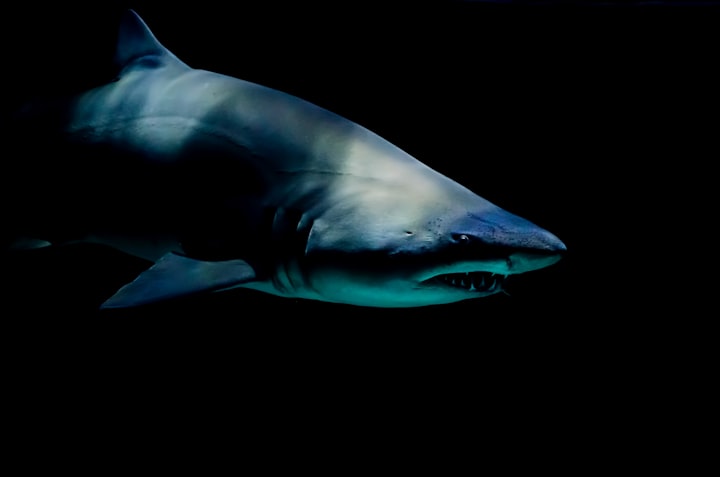Space Station Menagerie
Deep space aquarium

"Log begins. Dr. Kendra Simms reporting, 2230 UTC, 12 May, 2086. Beginning a twelve hour shift; on my first walk through I've observed that the school of Bluefin appears to be adjusting reasonably to the reduced gravity, while the Spotted Eagle Rays continue to struggle. The giant octopus, after 312 days, seems to be fully adapted to its new environment. Current observations continue to support my theory that a majority of aquatic life needs a minimum of 40 percent of Earth's gravity to thrive. As to Maggie, our newest specimen…" Dr. Simms paused her recording and leaned over the railing, watching the specimen swim below her.
Dr. Kendra Simms was lead scientist aboard the DSRS Menagerie. Menagerie was a Deep Space Relay Station (DSRS). In fact, she was the first Relay Station, locked in orbit past the far side of the moon. The space station had been in operation 717 days so far, and Dr. Simms had been in charge for 498 days. She took command when the station was deemed to be stable and fully operational, and the first of the experimental specimens arrived.
The long term purpose of the DSRS Menagerie was to be a launching point for interstellar exploration vessels, but as the first interstellar mission wasn't scheduled until 2090, it's current use was as a science station, experimenting with different animals, testing to see what conditions they would and wouldn't be able to endure. The first specimens were small, aquatic invertebrates, and they were increasing both the size and complexity of the specimens with each successive trial. The goal was to find which creatures would be capable of surviving long term space travel. The reasons for wanting animal companions for these trips were several, from sustainable food sources, to potential relocation in the event of an Earth-like planet being found, to simple companionship and psychological comfort. Eventually they would be doing more extensive testing on land mammals, but Dr. Simms specialty was the effects of artificial environments on Marine Biology.
The current subject of Dr. Simms' observations was the new arrival, Maggie. Dr. Simms resumed her log.
"Maggie is an adult female tiger shark, approximately 4 and a half years old, currently 2.8 meters long and weighing 352kg. She arrived at the station 12 days ago, and is slowly adjusting to the artificial gravity and oxygen enriched saltwater. Her heart rate is slightly lower than was observed in her Earthside, averaging 7 beats per minute as she regained consciousness, and now averaging between 25-30 beats per minute. This decrease is consistent with most other creatures in a reduced gravity environment. As with all sharks, her temperature is the same as the surrounding waters, and though on Earth she was most active at 22C, here she appeared sluggish at that temperature, so I increased the water temperature to 26C and she has responded favorably."
Dr. Simms paused her recording once more, looking down into the oval tank that Maggie was in. At 20 cubic meters, it wasn't quite the largest tank they had, the tank with the Bluefin school was 28 cubic meters, but it was the largest for a single specimen. She checked the readings from the tank and resumed her log once more. "Maggie is recording an increased average speed of 4.5 kph, again consistent with moving in reduced gravity." Pausing the recording once more, Dr. Simms placed her digital recorder on the workstation, opened a section of the railing, and stepped off the edge, dropping the five meters into the water of Maggie's tank.
The water felt like a warm bath, the temperature reminiscent of the waters off the coast of the UAE. As she luxuriated in the feel, she felt more than saw the Tiger Shark swim past beneath her. Pulling her Rebreather from her pocket, Dr. Simms slipped it between her teeth and dove after Maggie.
The Rebreather was an extraordinary piece of technology that only worked in the Menagerie tanks. Because everything from the gravity to the light on Menagerie was artificial, there was very little natural oxygen mixing in this water. The solution was a hyperoxygenated gel slowly dissolved into the tanks. This kept the tanks at a level of 10.5-12 mg/L, which while normally toxic to aquatic life, seemed to keep them healthy in this environment. A secondary effect was the Rebreather, which could take the highly oxygenated water and pull the oxygen out. This kept them from having to keep bulky SCUBA gear on the space station, instead using a device slightly larger than a harmonica.
Swimming down, Dr. Simms slowed her descent at about 3 meters below the surface, floating in place. It was still strange to her, over a year later, that despite living on a space station, the only time she could experience weightlessness was still when she was underwater. Maggie seemed to prefer a depth of between 5-6 meters, so Dr. Simms could watch her closely from here while staying out of her way. Maggie swam passed once more.
Maggie's flanks still had fairly noticeable striping, her alternating light and dark gray swathes showing how her species got its name. Her blank black eyes reflected the blue-white light from the tank's LED bars. Her large mouth showed most of her 48 teeth, set in two separate rows in the upper jaw as well as the lower jaw. Her lengthened dorsal and caudal fins cut sharply through the water as she swam closer.
As Maggie passed closely by her, Dr. Simms reached out and lightly swept her hand down the shark's flank. The rough, sandpaper-like skin scratched across her palms, and Dr. Simms could feel Maggie's muscles rippling beneath the skin. When her hand made contact with Maggie, Dr. Simms' imagination took hold, and for an instant she was the shark, the ancient predator that ruled the fathomless ocean, slightly perturbed at the new and unusual environment she found herself in. The water tasted strange, and the sun didn't warm her back like it once did. There were less fish around her, still plenty to eat, but not the plethora she was used to. There was a human in her waters, but it was inconsequential. She was still the only shark in the water, which meant that she ruled.
Dr. Simms pulled her hand from the flank, coming back to herself. Maggie swam serenely on, ignoring Dr. Simms entirely. Dr. Simms watched her swim another lap or two before exiting the water. Drying herself off, she climbed back up to the walkway overhead, reclaiming the digital recorder. "Observation; based on personal analysis of her behavior, it is my opinion that Maggie will adjust well to the new environment. Sharks have been in the water longer than man has been on land. They should take the next step with us."
About the Creator
Justin Elliott
An aspiring writer that's just trying to hone his skills in his spare time.







Comments
There are no comments for this story
Be the first to respond and start the conversation.